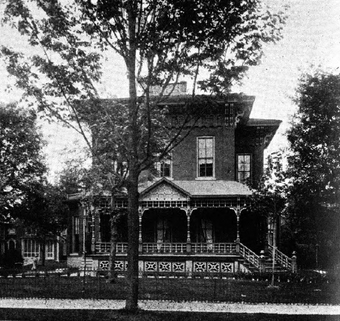West Pearl Street Historic District facts for kids
Quick facts for kids |
|
|
West Pearl Street Historic District
|
|

George Starr House (166 W. Pearl), 1906
|
|
| Location | 155-225 and 160-208 W. Pearl St., Coldwater, Michigan |
|---|---|
| Area | 5.5 acres (2.2 ha) |
| Architect | Saxton, Ebenezer B.; Parker, Marcellus H. |
| Architectural style | Stick/eastlake, Greek Revival, Italianate |
| NRHP reference No. | 90001122 |
| Added to NRHP | July 26, 1990 |
The West Pearl Street Historic District is a special neighborhood in Coldwater, Michigan. It's known for its beautiful old homes. This area is officially recognized as a historic district. It was added to the National Register of Historic Places in 1990. This means its history and buildings are important to protect.
Contents
Discovering West Pearl Street's Past
After the American Civil War ended, the city of Coldwater grew very quickly. Many new and large homes were built. People wanted to live in nice areas just outside the busy downtown. West Pearl Street became one of these popular places.
Who Lived on West Pearl Street?
The oldest house in this district is the Brown-Halstad House. It was built way back in 1860. Many important people from Coldwater's early days lived here. They helped the city grow and become what it is today.
- Lorenzo D. Halsted (165 W. Pearl): He helped start Coldwater's first factory. It made tobacco products like cigars.
- George Starr (166 W. Pearl): He was a top leader at the Coldwater National Bank. He helped manage money for the city.
- Lester E. Rose (186 West Pearl): He was the president of another big bank, the Southern Michigan National Bank.
- William A. Coombs (199 West Pearl): He owned a company called Coombs Milling Company. They likely processed grains.
- Robert G. Chandler (200 West Pearl): He was part of A. Chandler & Son. This was one of the first hardware stores in the area.
Exploring the Architecture of West Pearl Street
The West Pearl Street Historic District stretches for two blocks. It's close to Coldwater's main business area. This district is special because it has many large homes built in the late 1800s.
What Kinds of Houses Can You See?
There are 18 buildings in the district. Fifteen of these buildings are important to its history. Three of them are old carriage houses, which were like garages for horses and buggies. The houses show off many different building styles.
You can see homes built in the Greek Revival style. These often look like ancient Greek temples. There are also Italianate houses, which might have tall windows and decorative eaves. You'll also find Stick and Eastlake houses. These styles use lots of decorative wooden trim. Some homes are also in the Colonial Revival style. Many of these houses sit on large, spacious lots.



